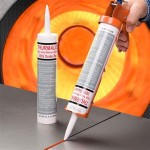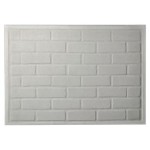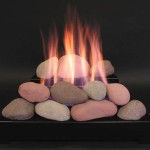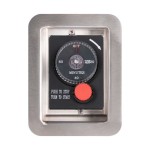Understanding Ventless Propane Gas Fireplaces
Ventless propane gas fireplaces offer an alternative to traditional wood-burning fireplaces and vented gas fireplace systems. They are designed to operate without the need for a chimney or flue, providing a potentially simpler and more affordable installation process. However, understanding their functionality, safety considerations, and proper usage is paramount before considering this type of heating appliance. This article provides a detailed overview of ventless propane gas fireplaces, encompassing their operation, advantages, disadvantages, and essential safety precautions.
The fundamental principle behind a ventless propane gas fireplace is its efficient combustion process. These units are designed to burn propane gas almost completely, minimizing the production of harmful byproducts like carbon monoxide. This near-complete combustion is achieved through advanced burner technology and precise control of the air-to-fuel ratio. The result of this process is primarily heat, water vapor, and carbon dioxide.
The absence of a vent or chimney allows the heat generated by the fireplace to remain within the room, contributing to increased heating efficiency. This is in contrast to vented fireplaces, where a significant portion of the heat escapes through the flue. This potential energy savings is a key factor driving the popularity of ventless models. However, it also mandates careful consideration of indoor air quality and ventilation practices.
Ventless propane gas fireplaces are typically equipped with oxygen depletion sensors (ODS). This safety feature is designed to automatically shut off the gas supply if the oxygen level in the room drops below a predetermined threshold. This mechanism is crucial for preventing carbon monoxide buildup, particularly in enclosed spaces where adequate ventilation is lacking. The proper functioning of the ODS system is paramount for safe operation.
Installation of a ventless propane gas fireplace is generally considered simpler than installing a traditional or vented gas fireplace. The absence of venting requirements eliminates the need for extensive structural modifications to accommodate a chimney or flue. This can lead to reduced installation costs and greater flexibility in terms of placement within a room. However, professional installation is still recommended to ensure compliance with local building codes and proper gas line connections.
Key Point 1: Operation and Combustion Process
Ventless propane gas fireplaces rely on a highly efficient combustion process to minimize the production of harmful byproducts. The burner design is engineered to optimize the mixing of propane gas and air, resulting in a near-complete burn. This process converts the propane gas into heat, water vapor, and carbon dioxide, with minimal emissions of carbon monoxide or other pollutants. The efficiency of the combustion process is a critical factor in the safety and performance of these appliances.
The air-to-fuel ratio is precisely controlled within the burner system. This control is essential for maintaining optimal combustion and minimizing the formation of incomplete combustion products. Manufacturers often employ sophisticated burner designs and control systems to achieve this precise control. The design of the burner also influences the flame appearance, contributing to the aesthetic appeal of the fireplace.
The oxygen depletion sensor (ODS) plays a crucial role in monitoring the oxygen level in the room. The ODS is a thermocouple-based device that senses the presence of sufficient oxygen. If the oxygen level drops below a safe threshold, the ODS triggers the automatic shut-off valve, cutting off the gas supply to the fireplace. This prevents the accumulation of carbon monoxide, which can be fatal. Regular maintenance and testing of the ODS are vital for ensuring its proper functioning.
The water vapor produced during combustion is released into the room. In some cases, this can contribute to increased humidity levels, which may be beneficial in dry climates. However, excessive humidity can lead to condensation problems and mold growth in poorly ventilated spaces. Therefore, monitoring humidity levels and ensuring adequate ventilation are important considerations when using a ventless propane gas fireplace.
The heat generated by the combustion process directly warms the air in the room. The absence of venting allows the heat to remain within the living space, contributing to increased heating efficiency. This makes ventless fireplaces a potentially cost-effective heating solution, especially in well-insulated homes. However, it also necessitates careful attention to ventilation to maintain air quality and prevent the buildup of combustion byproducts.
Key Point 2: Safety Considerations and Regulations
Safety is the paramount concern when operating any gas-burning appliance, including ventless propane gas fireplaces. While these appliances are designed with safety features, such as the ODS, adherence to safety guidelines and proper installation are crucial. Local building codes and regulations often govern the installation and use of ventless fireplaces, and compliance with these regulations is mandatory.
Proper ventilation is essential when using a ventless propane gas fireplace. While these appliances do not require a chimney or flue, they do require adequate airflow to ensure that combustion byproducts are properly diluted and removed from the room. Open a window or door slightly to provide fresh air circulation. The frequency and duration of ventilation will depend on the size of the room, the size of the fireplace, and the number of occupants.
Carbon monoxide detectors are strongly recommended in homes with ventless propane gas fireplaces. These detectors provide an early warning system in case of carbon monoxide buildup. Place carbon monoxide detectors in strategic locations throughout the home, following the manufacturer's instructions. Test the detectors regularly to ensure that they are functioning properly. Replace the batteries in the detectors at least twice a year.
Regular maintenance is crucial for ensuring the safe and efficient operation of a ventless propane gas fireplace. Clean the burner assembly periodically to remove dust and debris that can interfere with combustion. Inspect the gas line connections for leaks. Check the ODS to ensure that it is functioning properly. If you notice any unusual odors or malfunctions, immediately turn off the fireplace and contact a qualified technician.
Never use a ventless propane gas fireplace in a bedroom or other enclosed space where people sleep. The risk of carbon monoxide poisoning is higher in these situations. Use ventless fireplaces only in well-ventilated living areas. Never leave a ventless fireplace unattended, especially when children or pets are present. Keep flammable materials away from the fireplace to prevent fire hazards.
Key Point 3: Advantages and Disadvantages
Ventless propane gas fireplaces offer several advantages over traditional fireplaces and vented gas fireplace systems. These advantages include ease of installation, increased heating efficiency, and greater flexibility in terms of placement within a room. However, they also have some disadvantages, such as potential indoor air quality concerns and the need for careful ventilation.
The primary advantage of ventless propane gas fireplaces is the simplified installation process. The absence of venting requirements eliminates the need for extensive structural modifications. This can significantly reduce installation costs and make these fireplaces an attractive option for homeowners who want to add a fireplace without the expense and complexity of installing a chimney or flue.
Increased heating efficiency is another key benefit of ventless models. Because the heat generated by the fireplace remains within the room, ventless systems can provide more efficient heating than vented systems, where a significant portion of the heat escapes through the flue. This can translate into lower energy bills and a more comfortable indoor environment.
The absence of venting requirements allows for greater flexibility in terms of placement within a room. Ventless fireplaces can be installed in locations where a traditional fireplace or vented gas fireplace would be impractical or impossible to install. This can open up new design possibilities for homeowners who want to incorporate a fireplace into their living space.
However, ventless propane gas fireplaces also have some disadvantages. The primary concern is the potential impact on indoor air quality. While these appliances are designed to burn propane gas almost completely, they still produce some combustion byproducts, such as water vapor and carbon dioxide. In poorly ventilated spaces, these byproducts can accumulate and potentially pose health risks. Therefore, adequate ventilation is essential when using a ventless propane gas fireplace.
Another potential disadvantage is the limited heat output of some ventless models. While they can provide supplemental heating, they may not be suitable for heating large areas or for use as a primary heating source. The heat output of a ventless fireplace is typically measured in British thermal units (BTUs). Choose a fireplace with a BTU rating that is appropriate for the size of the room you want to heat.
The aesthetic appeal of ventless propane gas fireplaces can also be a consideration. Some people prefer the appearance of a real wood-burning fire. While ventless models can mimic the look of a traditional fireplace, they may not provide the same ambiance or the same authentic experience. However, advancements in burner technology have led to more realistic flame patterns and improved overall aesthetics in ventless models.
:max_bytes(150000):strip_icc()/ventless-gas-fireplaces-4160746-hero-f9d4bdcd9bd446eb84406de306f790ba.jpg?strip=all)
How To Pick Out A Ventless Gas Fireplace

Ventless Gas Fireplace Propane

Pleasant Hearth 27 500 Btu 42 In Convertible Ventless Propane Gas Fireplace Cherry Vff Ph26lp The Home Depot

Duluth Forge Ventless Propane Gas Log Set 22 In Winter Oak 32 000 Buyersdepot Com

What Is A Ventless Gas Fireplace Dorr Oil

Duluth Forge 41 75 In Black Ventless Natural Or Liquid Propane Gas Fireplace The Fireplaces Department At Com

Radiance Vent Free Gas Stove The Place

Duluth Forge Dual Fuel Ventless Gas Fireplace 32 000 Btu T Stat Control Antique White Finish Com

Empire 29 Loft Small Vent Free Gas Fireplace 10 000 Btu Vflc10in32 Hvacdirect Com

Duluth Forge 55 In Black Ventless Natural Or Liquid Propane Gas Fireplace The Fireplaces Department At Com








